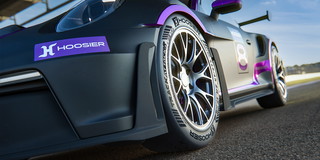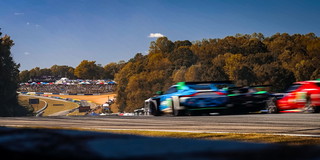
In the paddock on any given weekend, half the drivers will offer effusive praise of virtual racing’s ability to bring them up to speed while the other half will say they don’t get it. But the reality is, even those using a motorsports sim on a regular basis might not be utilizing their sim to its fullest. Yes, they’ve likely found a car in the software that represents their real-world track car, and perhaps they’ve even tweaked settings to dial it in, but there’s a whole different level of tuning a sim that makes virtual racing setups next-level driving tools for those looking to improve their speed in the real world. It’s the secret sauce that makes the difference.
“Our end goal is not to make the sim driving experience the best it can be,” explains Joe Eilert from Spark Virtual Racing. “The goal is to make the sim driving experience as informative and intuitive as possible so that the racing you do in the real world improves as much as possible.”
Eilert is co-owner and Chief Technology Officer of Spark Virtual Racing, a company that produces three levels of sim racing setups, the entry level $22,500 S100, the $43,500 S300, and the $86,500 S600. Units build on the previous model with options advancing with each, but the philosophy remains the same.
“Other sim companies want to make their sim so that the sim racing is as great as possible,” he explains. “Our goal is to make you as good in the real world as possible. That means the tuning is not entertainment based – it’s based on information that helps you drive the sim like you would drive a normal car. You shouldn’t drive a sim different from how you’re driving your track car – and if you’re driving your sim different, then it’s not a training tool, it’s not going to help you.”
Spark Virtual Racing is taking virtual-to-real-world racing one step further, too. As the Exclusive Simulator Partner of the SCCA®, Spark Virtual Racing is offering a lifetime membership to the Sports Car Club of America for free with the purchase of an S100 unit (that’s a $1,800 value). Meanwhile, the S300 comes with two lifetime memberships to the SCCA, with the S600 offering three lifetime memberships. This allows Spark Virtual Racing sim owners the ability to experience SCCA themselves, with S300 and S600 owners also able to gift lifetime SCCA memberships to friends and family.
Eilert doesn’t just hold a fancy title at Spark Virtual Racing, he writes the code, so he truly understands what goes into making a sim setup a useful driver training tool. “We try to make it so the sim drives, behaves, and responds the same as your car,” Eilert says. “For example, our motion platform doesn’t move that much because the smaller the movements, the faster they can occur, and in the real world, everything is instantaneous. In the sim world, everything has to have some amount of latency, because everything has to be processed and then presented to you, whether that’s visually, in the audio, tactilely. What we try to do is make sure everything is as quick as possible, and matches what you see, what you feel, what you hear.”
Eilert’s background is an impressive one. Holding a masters in aeronautical engineering with a focus in experimental fluid dynamics and active flow control, he worked on hydrodynamics for what is essentially a nuclear submarine company. “Through that, I got exposure to all of the craziest software you could imagine,” he explains. “Essentially, I’m a pretty terrible employee because I really like building my own stuff. I spent all of my time doing experimental code and things like that when I was probably supposed to be doing other projects.”
He and Matt McGivern, who co-owns Spark Virtual Racing alongside Eilert, started a virtual reality arcade, then launched the first virtual reality racing center in the country, with Eilert solving technology problems along the way. That came to an end when COVID hit, but rather than shuttering the company, the pair took all they’d learned and created Spark Virtual Racing, producing racing simulators that would provide value to real-world drivers.
So what’s the secret sauce? After all, software like iRacing, Assetto Corsa, and rFactor 2 (which is the sim software of choice for Spark Virtual Racing) allows users to tweak their settings already.
“There are multiple pieces of software that are working together,” Eilert explains. “For example, our motion profile is controlled by a separate piece of software that’s running special code that adjusts how much it leans when you accelerate or go over a curb, or how much it rotates based on what tire slip angle you have in the rear versus the front. All of that runs in a separate program.”
Spark Virtual Racing’s proprietary code offers them the ability to tweak and update profiles on the fly. “Right now we run five different pieces of haptics in our system: one on the seat, one that’s experimental on the steering wheel, and one for each pedal,” he says. “Each one of those has its own code that you can’t download anywhere – it’s ours. I write the code based on feedback from tons of drivers and physics, and physics takes priority over feedback. We try to balance it, though, so it does communicate how drivers are able to process it.”
The haptic feedback on the pedals is so detailed, Eilert explains, that drivers can even feel pulsing from the car’s anti-lock brake system.
There’s roughly 5,000 hours of work in Spark Virtual Racing’s software tuning, extending well beyond what sim owners would be able to do on their own. “For the steering wheel itself, there’s a lot of settings in the software that’s presented to the user, and then there’s tons of other tweaks that can be made in a text file that the majority of users don’t know exist and most people don’t mess with,” says Eilert. “That’s the difference between someone who buys the hardware and plugs it in, and what we do. If you buy the hardware, you’d never go in and adjust the text files and .ini files to set how the torque curves work.”
As part of its customer support program, Spark Virtual Racing works with each customer to find a vehicle that’s most representative of the customer’s car for use in rFactor 2. Most times, that involves little more than a few tweaks in the software, but for those looking for the ultimate setup, Spark Virtual Racing can assist in building a completely custom vehicle from the ground up (that last one costs a bit extra).
For something like Spark Virtual Racing’s S100 setup, piecing the components together yourself would account for as much as 60 percent of the cost of the unit. The remaining 40 percent of the price covers Spark’s custom software, those 5,000 hours’ worth of R&D, and a year of customer support that’s valued at $2,500. Add in the SCCA lifetime membership that comes with the S100 and a year’s subscription to Blayze for driver coaching – not to mention that Spark Virtual Racing’s rig has a “go race” button that greatly simplifies the process of booting up the sim – and the setup’s value soon becomes apparent.
All of this is to say that not all racing sim setups are equal, and those who don’t yet extol the virtues of racing simulators as a driver’s tool might simply be using the wrong one. But it turns out, even those with a home sim setup might not be fully utilizing the tool.
Is there a secret sauce to sim? Indeed there is.
Click here to learn more about Spark Virtual Racing, and to order a racing sim of your own.
Photo courtesy Spark Virtual Racing (S600 unit shown)










